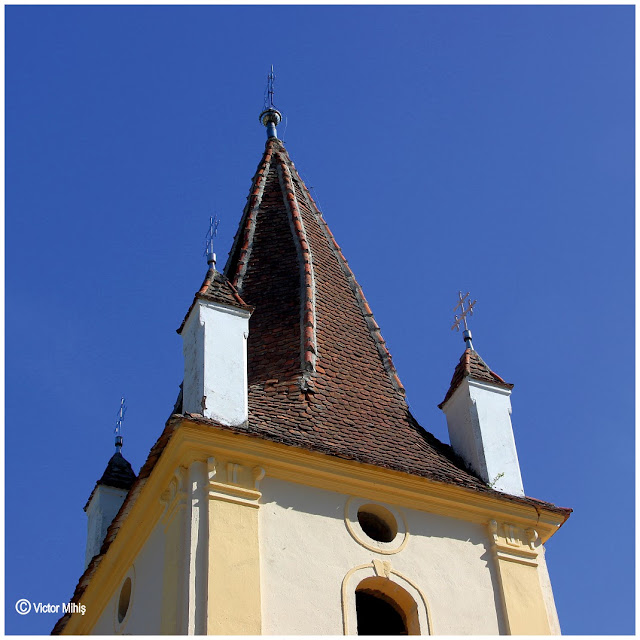MAGNA VILLA VALACHICALIS
o bună parte din farmecul Transilvaniei de sud este dat de civilizația sașilor stabiliți aici la începutul mileniului doi... cultura, tehnica, rigoarea saxonă, au marcat dezvoltarea așezărilor, a zonei...
aproape că în fiecare sat găsești situri construite, biserici, fortificații, expresie a culturii și civilizației sașilor transilvăneni...
caracterul sudului Transilvaniei este dat de caracterul civilizației sașilor...
dar,
am fost încântat să găsesc un loc cu edificii românești vechi, semnificative...
ceea ce mi-a plăcut, a fost faptul că lăcașuri de cult de rit bizantin, românești, au împrumutat din caracterul arhitecturii catolice, sau evanghelice, a sașilor...
da, e vorba de SĂLIȘTEA SIBIULUI, sau Magna Villa Valachicalis (Marele Sat al Românilor), sau Grossdorf, sau Langesdorf)
da, e vorba de SĂLIȘTEA SIBIULUI, sau Magna Villa Valachicalis (Marele Sat al Românilor), sau Grossdorf, sau Langesdorf)
most of the southern Transylvanian charm is due to the civilization of the saxons that established here in the begining of the second millenium... the culture, the technique, the saxon rigour, marked the development of the settlements, of the entire region...
in almost every single village you find buildings, churches, fortifications, as an expression of the transylvanian saxons heritage...
the character of the southern Transylvania is given by the character of saxon civilzation...
but,
I was happy to find a place with significant old buildings...
I liked that romanian byzantine churches borrowed from the character of saxon catholic and evengelical churches...
I liked that romanian byzantine churches borrowed from the character of saxon catholic and evengelical churches...
yes, it is SĂLIȘTE, SIBIU, or Magna Villa Valachicalis (Great Village of Romanians), or Grossdorf, or Langesdorf)
BISERICA DIN GRUI
THE CHURCH FROM GRUI
frumoasa Transilvania: dealuri, văi, satele și bisericile lor
beautiful Transylvania: hills, valleys, villages and their churches
Săliște este atestat documentar din 1354, din 1383 ca „Marele sat al Românilor”...
biserica din Grui este datată 1742, cu turnul clopotniță adăugat în 1816...
o privire atentă te face să sesizezi diferențele de execuție, finisaje, dintre naos cu altar, și turn...
Săliște is testified in documents in 1354, and since 1383 as „The Great Village of Romanians”...
the church from Grui is dated 1742, with the bell tower added in 1816...
a closer look makes you notice the differences of execution, finishes, between the nave with altar, and the tower...
turnul este cel ce nu seamănă deloc cu cele ortodoxe, este similar celor săsești...
eu știu că semnificația originală a celor patru turnulețe este faptul că în acea localitate există complet de judecată ce are dreptul de a condamna la moarte...știu că există și explicația că cele patru turnulețe reprezintă cei patru evangheliști...
the spire is the one that doesn't resemble at all with the orthodox ones, it's similar to the saxon ones...
I know that the original significance of the four small spires is that in that locality there is formation of the court that is entitled to give sentences to death...
I know there is also the explanation for the four spires as they represent the four evangelists...
dacă acoperișul ți se pare că nu e în regulă, că s-a întâmplat ceva, să muchiile coamelor sunt frânte și ar trebui reparate, atunci te înșeli... senzația asta am avut-o și eu...
se spune că în acele vremuri, dulgherii își arătau măiestria torsionând, răsucind conul acoperișului, într-un fel de spirală... în cele mai multe cazuri rezultatele sunt timide, ca aici...
cel mai reușit exemplu pe care eu l-am văzut, este la Cristian, lângă Sibiu...
they say that those days, the carpenters wanted to show their mastery, turning, making the cone of the roof twisted, in a kind of spiral... in most of the cases, the results are sheepish, like here...
the best example I met, is at Cristian, near Sibiu
acoperișul torsionat de la Cristian (Sibiu)
the torsioned roof at Cristian (Sibiu)
„BISERICA MARE” ÎNĂLȚAREA DOMNULUI
„THE GREAT CHURCH” OF THE ASCENSION OF THE LORD
foarte interesantă biserica, sfințită în 1786...
interesant ritmul ferestrelor și al nișelor pictate parțial în prezent...
a very interesting church, established in 1786...
very interesting the rythm of the windows and the partially painted alcoves...
turnul este 100% săsesc...
the tower is 100% saxon...






















0 comentarii:
Trimiteți un comentariu